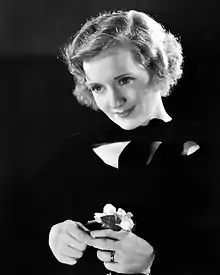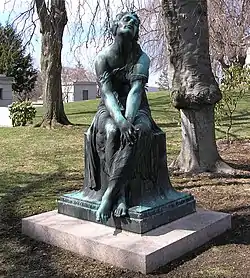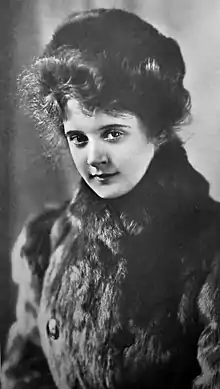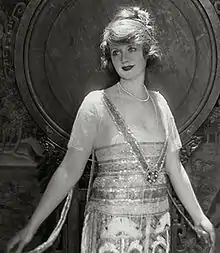Billie Burke | |
|---|---|
 Burke in 1933 | |
| Born | Mary William Ethelbert Appleton Burke August 7, 1884 Washington, D.C., U.S. |
| Died | May 14, 1970 (aged 85) Los Angeles, California, U.S. |
| Resting place | Kensico Cemetery |
| Occupation | Actress |
| Years active | 1903–1960 |
| Known for | Glinda the Good Witch in The Wizard of Oz |
| Spouse | |
| Children | Patricia Ziegfeld Stephenson |
| Signature | |
 | |
Mary William Ethelbert Appleton Burke (August 7, 1884 – May 14, 1970) was a British-American actress who was famous on Broadway and radio, and in silent and sound films. She is best known to modern audiences as Glinda the Good Witch of the North in the Metro-Goldwyn-Mayer movie musical The Wizard of Oz (1939).
Burke was nominated for the Academy Award for Best Supporting Actress for her performance as Emily Kilbourne in Merrily We Live (1938). She is also remembered for her appearances in the Topper film series. Her unmistakable high-pitched, quivering and aristocratic voice, made her a frequent choice to play dimwitted or spoiled society types.
She was married to Broadway producer and impresario Florenz Ziegfeld Jr. from 1914 until his death in 1932.
Early life
Burke was born in Washington, D.C., the daughter of Blanche (née Beatty) and her second husband, William "Billy" Ethelbert Burke. She toured the United States and Europe with her father, a singer and clown who worked for the Barnum & Bailey Circus. Her family settled in London where she attended plays in the West End. She began acting on stage in 1903, making her debut in London in The School Girl.[1] Her other London shows included The Duchess of Dantzic (1903) and The Blue Moon (1904). She eventually returned to America to star in Broadway musical comedies.
Career


Burke went on to play leads on Broadway in Mrs. Dot,[2] Suzanne,[3] The Runaway, The "Mind-the-Paint" Girl, and The Land of Promise from 1910 to 1913, along with a supporting role in the revival of Sir Arthur Wing Pinero's The Amazons. There she met producer Florenz Ziegfeld, marrying him in 1914. Two years later they had a daughter, author Patricia Ziegfeld Stephenson (1916–2008).[4]
Burke was signed for the movies and made her cinematic debut in the title role of Peggy (1915). Her success was phenomenal, and she was soon earning what was reputedly the highest salary of any film actress up to that time.[5] She followed her first feature with the 15-part serial Gloria's Romance (1916), another popular and critically acclaimed vehicle. By 1917, she was a favorite with silent-movie fans, rivaling Mary Pickford, Lillian Gish, Clara Kimball Young and Irene Castle. She starred primarily in provocative society dramas and comedies, similar in theme to The "Mind-the-Paint" Girl, her most successful American play. Her girlish charm rivaled her acting ability, and as she dressed to the hilt in fashionable gowns, furs and jewelry, her clothes sense also won her the devotion of female audiences. Among the films in which she appeared during this period were Arms and the Girl (1917), The Mysterious Miss Terry, Let's Get a Divorce (1918), Good Gracious, Annabelle (1919), Away Goes Prudence (1920) and The Frisky Mrs. Johnson (1920). As a nod to himself for his wife appearing for Zukor and Lasky, Ziegfeld insisted on promotions for each of the films to carry the tag "By Special Arrangement with Florenz Ziegfeld".
Burke's beauty and taste made her a major trendsetter throughout the 1910s and 20s. As early as 1909, following her Broadway performance in My Wife (1909), department stores began carrying the "Billie Burke Dress" with a signature flat collar and lace trim.[6] During this time, much of Burke's on- and off-screen wardrobe was provided by the leading European couturier Lucile (in private life, Lady Duff Gordon), whose New York branch was the fashion Mecca of socialites and entertainment celebrities.[7] Burke reflected on her reputation as "a new kind of actress, carefree, and red-headed, and I had beautiful clothes."[8]
In 1916, Burke had a daughter. In 1917, Burke endorsed Pond’s Vanishing Cream.[9]
Despite her success in film, Burke eventually returned to the stage, appearing in Caesar's Wife (1919), The Intimate Strangers (1921), The Marquise (1927) and The Happy Husband (1928).
When the family's investments were wiped out in the Wall Street Crash the following year, she resumed screen acting to aid her husband.
Burke made her Hollywood comeback in 1932, when she starred as Margaret Fairfield in A Bill of Divorcement, which was directed by George Cukor. She played Katharine Hepburn's mother in the film, which was Hepburn's debut. Despite the death of her husband Florenz Ziegfeld during the film's production, she resumed acting shortly after his funeral.
.jpg.webp)
In 1933, Burke was cast as Millicent Jordan, a scatterbrained high-society woman hosting a dinner party in the comedy Dinner at Eight, directed by George Cukor, co-starring with Lionel Barrymore, Marie Dressler, John Barrymore, Jean Harlow and Wallace Beery. The movie was a great success and revitalized her career. She subsequently starred in many comedies and musicals, typecast as a ditzy, feather-brained upper-class matron, with her high-pitched voice.
In 1936, Metro-Goldwyn-Mayer filmed a biopic of Florenz Ziegfeld (The Great Ziegfeld), a film that won Academy Awards for Best Picture and Best Actress (Luise Rainer as Ziegfeld's common-law wife, Anna Held). William Powell played Ziegfeld and Myrna Loy played Burke; this infuriated Burke, who was under contract to the studio and believed she could have played herself, however, MGM considered her too old to cast in the part of her younger self.
Burke appeared in Topper (1937) in which she played the twittering and puritanical Clara Topper, who is married to a man haunted by socialite ghosts played by Cary Grant and Constance Bennett. She returned to the role in the film's sequels. Her next performance as Emily Kilbourne in Merrily We Live (1938) resulted in her only Oscar nomination. In 1938, she was chosen to play Glinda the Good Witch of the North in the musical The Wizard of Oz (1939), directed by Victor Fleming, starring Judy Garland. She had previously worked with Garland in the film Everybody Sing, in which she played Judy's histrionically hysterical actress-mother. Director George Cukor offered her the role of Aunt Pittypat in Gone With the Wind (1939), but she declined it. The role went to Laura Hope Crews, in a performance that Cukor wanted to be played in a "Billie Burke-ish manner" with "the same zany feeling".[10] Another successful film series followed with Father of the Bride (1950) and Father's Little Dividend (1951), both directed by Vincente Minnelli and starring Spencer Tracy, Joan Bennett, and Elizabeth Taylor. Burke also portrayed Mrs. Ernest (Daisy) Stanley in the 1942 film The Man Who Came to Dinner.
Burke wrote two autobiographies, both with Cameron Shipp, With a Feather on My Nose (Appleton 1949) and With Powder on My Nose (Coward McCann, 1959).
Radio and television

On CBS Radio, The Billie Burke Show was heard on Saturday mornings from April 3, 1943, until September 21, 1946. Sponsored by Listerine, this situation comedy was initially titled Fashions in Rations during its first year. Portraying herself as a featherbrained Good Samaritan who lived "in the little white house on Sunnyview Lane," she always offered a helping hand to those in her neighborhood. She worked often in early television, appearing in the short-lived sitcom Doc Corkle (1952). She was a guest star on several TV and radio series, including Duffy's Tavern.
On television, Burke starred in her own talk show, At Home With Billie Burke, which ran on the DuMont Television Network from June 1951 through the spring of 1952. She was one of the first female talk show hosts, after the hostesses of the earlier DuMont series And Everything Nice (1949–50) and Fashions on Parade (1948–49) which both included some talk show segments.
Billie Burke starred in an adaptation of Dr. Heidegger's Experiment on the TV version of Lights Out on November 20, 1950.[11]
Return to stage and final film
Burke tried to make a comeback on the New York stage. She starred in two short-lived productions: This Rock and Mrs. January and Mr. X. Although she got good reviews, the plays did not. She also appeared in several plays in California, although her mind became clouded, and she had trouble remembering lines. In the late 1950s, her failing memory led to her retirement from show business, although her explanation at the time was, "Acting just wasn't any fun anymore."
Burke made her final screen appearance in Sergeant Rutledge (1960), a western directed by John Ford.
Personal life

Among Burke's early suitors was the operatic tenor Enrico Caruso.
In 1910, Burke bought the Kirkham estate on Broadway in Hastings-on-Hudson, New York, and renamed the mansion, Burkeley Crest.[12]
In April 1914, Burke married Florenz Ziegfeld. [13]
In 1921, Burke retired to raise her daughter Patricia, but resumed work after the Wall Street Crash of 1929.[14]
In 1932, Burke moved from New York to Beverly Hills, California, after the death of Ziegfeld.[15]
Burke died in Los Angeles of natural causes on May 14, 1970,[16] at the age of 85, and she was interred beside Ziegfeld at Kensico Cemetery, Valhalla, Westchester County, New York.
Legacy
For many years, Burke's framed photo was displayed above the exit staircase at New York City's Ziegfeld Theatre, but it disappeared after renovations. An opening-night program bearing a picture of her from her 1912 triumph The Mind the Paint Girl (Sir Arthur Wing Pinero) is displayed in the lobby of the Lyceum Theatre in Manhattan.
For her contributions to the film industry, Burke was inducted into the Hollywood Walk of Fame in 1960 with a motion pictures star at 6617 Hollywood Boulevard.[17]
The Academy Film Archive houses the Florenz Ziegfeld-Billie Burke Collection, which consists primarily of home movies.[18]
On November 4, 2015, the crater Burke, near the north pole of the planet Mercury, was named after Billie Burke.[19]
Burke is referenced in the horror film The Exorcist III (1990). The character Kinderman says, "I have hobbies. In the meantime, we have cancer and mongoloid babies and murderers, monsters prowling the planet, even prowling this neighborhood, Father... right now, while our children suffer... and our loved ones die, and your God goes waltzing blithely through the universe like some kind of cosmic Billie Burke."[20]
Performance career
Radio

- The Ziegfeld Follies of the Air – 1932
- Doubting Thomas – 1935
- Good News of 1939 – 1938
- The Rudy Vallee Hour – 1939
- The Gulf Screen Guild Theater – 1939
- The Rudy Vallee Sealtest Show – 1940–41
- The Pepsodent Show – 1941
- The Billie Burke Show – 1943–1946
- Duffy's Tavern – 1944
- The Sealtest Village Store – 1944
- Mail Call – 1944
- The Charlie McCarthy Show – 1944–47
- Tribute to Ethel Barrymore – 1945
- The Rudy Vallee Show – 1945
- Show Stoppers – 1946
- The Danny Kaye Show – 1946
- WOR 25th Anniversary – 1947
- Your Movietown Radio Theatre – 1948
- The Eddie Cantor Pabst Blue Ribbon Show – 1948
- Family Theater – 1948–52
- This Is Show Business – CBS-TV, 1949
- The Martin and Lewis Show – 1949
- The Bill Stern Colgate Sports Newsreel – 1949
- Stagestruck – 1954
- Biography in Sound – 1955–56
Broadway

_-_5.jpg.webp)
- My Wife – 1907
- Love Watches – 1908
- Mrs. Dot – 1910
- Suzanne – 1910
- The Philosopher in the Apple Orchard – 1911
- The Runaway – 1911
- The Amazons – 1913
- The Land of Promise – 1913
- Jerry – 1914
- The Rescuing Angel – 1917
- A Marriage of Convenience – 1918
- Caesar's Wife – 1919
- The Intimate Strangers (musical)|The Intimate Strangers – 1921
- Rose Briar – 1922
- Annie Dear – 1924
- The Marquise – 1927
- The Happy Husband – 1928
- Family Affairs – 1929
- The Truth Game – 1930
- Ziegfeld Follies of 1934 – 1934 (producer)
- Ziegfeld Follies of 1936 – 1936 (producer)
- This Rock – 1943
- Ziegfeld Follies of 1943 – 1943 (producer)
- Mrs. January and Mr. X – 1944
Filmography
Silent
| Year | Title | Role | Notes |
|---|---|---|---|
| 1914 | Our Mutual Girl | Herself | Lost film |
| 1916 | Peggy | Peggy Cameron ' | Lost film |
| Gloria's Romance | Gloria Stafford | Lost film | |
| 1917 | The Mysterious Miss Terry | Mavis Terry | Lost film |
| Arms and the Girl | Ruth Sherwood | ||
| The Land of Promise | Nora Marsh | Lost film | |
| 1918 | Eve's Daughter | Irene Simpson-Bates | Lost film |
| Let's Get a Divorce | Mme. Cyprienne Marcey | Lost film | |
| In Pursuit of Polly | Polly Marsden | Lost film | |
| The Make-Believe Wife | Phyllis Ashbrook | Lost film | |
| 1919 | Good Gracious, Annabelle | Annabelle Leigh | Lost film |
| The Misleading Widow | Betty Taradine | Lost film | |
| Sadie Love | Sadie Love | Lost film | |
| Wanted: A Husband | Amanda Darcy Cole | Lost film | |
| 1920 | Away Goes Prudence | Prudence Thorne | Lost film |
| The Frisky Mrs. Johnson | Belle Johnson | Lost film | |
| 1921 | The Education of Elizabeth | Elizabeth Banks | Lost film |
Sound
| Year | Title | Role | Notes |
|---|---|---|---|
| 1929 | Glorifying the American Girl | Herself | Uncredited |
| 1932 | A Bill of Divorcement | Margaret | |
| 1933 | Christopher Strong | Lady Strong - His Wife | |
| Dinner at Eight | Millicent Jordan | ||
| Only Yesterday | Julia Warren | ||
| 1934 | Where Sinners Meet | Eustasia | |
| Finishing School | Her Mother / Mrs. Helen Crawford Radcliff | ||
| We're Rich Again | Mrs. Linda Page | ||
| Forsaking All Others | Aunt Paula | ||
| 1935 | Society Doctor | Mrs. Crane | |
| After Office Hours | Mrs. Norwood | ||
| Becky Sharp | Lady Bareacres | ||
| Doubting Thomas | Paula Brown | ||
| She Couldn't Take It | Mrs. Daniel Van Dyke | ||
| A Feather in Her Hat | Julia Trent Anders | ||
| Splendor | Clarissa | ||
| 1936 | My American Wife | Mrs. Robert Cantillon | |
| Piccadilly Jim | Eugenia Willis, Nesta's Sister | ||
| Craig's Wife | Mrs. Frazier | ||
| 1937 | Parnell | Clara Wood | |
| Topper | Mrs. Topper | ||
| The Bride Wore Red | Contessa di Meina | ||
| Navy Blue and Gold | Mrs. Alyce Gates | ||
| 1938 | Everybody Sing | Diana Bellaire | |
| Merrily We Live | Mrs. Kilbourne | ||
| The Young in Heart | Marmy Carleton | ||
| Topper Takes a Trip | Mrs. Topper | ||
| 1939 | Zenobia | Mrs. Tibbett | |
| Bridal Suite | Mrs. McGill | ||
| The Wizard of Oz | Glinda the Good Witch of the North | ||
| Eternally Yours | Aunt Abby | ||
| Remember? | Mrs. Bronson | ||
| 1940 | The Ghost Comes Home | Cora Adams | |
| And One Was Beautiful | Mrs. Julia Lattimer | ||
| Irene | Mrs. Vincent | ||
| The Captain Is a Lady | Blossy Stort | ||
| Dulcy | Eleanor Forbes | ||
| Hullabaloo | Penny Merriweather | ||
| 1941 | The Wild Man of Borneo | Bernice Marshall | |
| Topper Returns | Mrs. Topper | ||
| One Night in Lisbon | Catherine Enfilden | ||
| 1942 | The Man Who Came to Dinner | Daisy Stanley | |
| What's Cookin'? | Agatha Courtney | ||
| In This Our Life | Lavinia Timberlake | ||
| They All Kissed the Bride | Mrs. Drew | ||
| Girl Trouble | Mrs. Rowland | ||
| 1943 | Hi Diddle Diddle | Liza Prescott | |
| So's Your Uncle | Aunt Minerva | ||
| You're a Lucky Fellow, Mr. Smith | Aunt Harriet Crandall | ||
| Gildersleeve on Broadway | Mrs. Laura Chandler | ||
| 1945 | Swing Out, Sister | Jessica Mariman | |
| The Cheaters | Clara Pidgeon | ||
| 1946 | Breakfast in Hollywood | Mrs. Frances Cartwright | |
| The Bachelor's Daughters | Molly Burns | ||
| 1948 | Billie Gets Her Man | Billie Baxter | Short film |
| 1949 | The Barkleys of Broadway | Mrs. Livingston Belney | |
| And Baby Makes Three | Mrs. Marvin Fletcher | ||
| 1950 | The Boy from Indiana | Zelda Bagley | |
| Father of the Bride | Doris Dunstan | ||
| Three Husbands | Mrs. Jenny Bard Whittaker | ||
| 1951 | Father's Little Dividend | Doris Dunstan | |
| 1953 | Small Town Girl | Mrs. Livingston | |
| 1959 | The Young Philadelphians | Mrs. J. Arthur Allen | |
| 1960 | Sergeant Rutledge | Mrs. Cordelia Fosgate | |
| Pepe | Herself |
See also
References
- ↑ "The School Girl a Hit". The New York Times, May 10, 1903, accessed February 20, 2011
- ↑ Mrs. Ziegfeld: The Public and Private Lives of Billie Burke, p. 50.
- ↑ Hampton's magazine, Volume 26, Page 362.
- ↑ "Patricia Ziegfeld Stephenson, Daughter of Legendary Broadway Impresario". Jazz News. April 25, 2008. Archived from the original on April 29, 2008. Retrieved May 11, 2008.
- ↑ "Glinda the Good Witch: The Early Years". Oscars.org | Academy of Motion Picture Arts and Sciences. August 4, 2015. Retrieved March 6, 2019.
- ↑ Schweitzer, Marlis (January 31, 2009). When Broadway Was the Runway. Philadelphia: University of Pennsylvania Press. doi:10.9783/9780812206166. ISBN 9780812206166.
- ↑ Marlis Schweitzer (2008). "Patriotic Acts of Consumption: Lucile (Lady Duff Gordon) and the Vaudeville Fashion Show Craze". Theatre Journal. 60 (4): 585–608. doi:10.1353/tj.0.0111. ISSN 1086-332X. S2CID 191481377.
- ↑ DeBauche, LM (March 2008). "Testimonial Advertising Using Movie Stars In The 1910s: How Billie Burke Came to Sell Pond's Vanishing Cream in 1917". Journal of Macromarketing. 28 (1): 87 – via Sage.
- ↑ DeBauche, Leslie Midkiff (May 1, 2007). "Testimonial Advertising Using Movie Stars in the 1910s: How Billie Burke Came to Sell Pond's Vanishing Cream in 1917". Proceedings of the Conference on Historical Analysis and Research in Marketing. 13: 146–156. Retrieved June 4, 2022.
- ↑ Wilson, Steve (2014). The Making of Gone With the Wind. University of Texas Press. p. 86. ISBN 978-0-292-76126-1.
- ↑ "Television . . . . . . Highlights of the Week". Detroit Free Press. November 19, 1950. p. 22. Retrieved April 13, 2021 – via Newspapers.com.
- ↑ "Billie Burke and Burkeley Crest". Hastings Historical Society. September 14, 2009. Retrieved June 4, 2022.
- ↑ "BILLIE BURKE WEDS.; Now Mrs. F. Ziegfeld -- Married in Hoboken After Matinee". The New York Times. April 13, 1914. Retrieved June 4, 2022.
- ↑ "Burke, Billie, 1885-1970". Social Networks and Archival Context. Retrieved June 4, 2022.
- ↑ Mitchell Owens, Legendary Hollywood Stars at Home, Architectural Digest
- ↑ "Billie Burke Dead; Movie Comedienne". The New York Times. May 16, 1970.
- ↑ "Hollywood Walk of Fame - Billie Burke". walkoffame.com. Hollywood Chamber of Commerce. Retrieved December 28, 2017.
- ↑ "Florenz Ziegfeld-Billie Burke Collection". Academy Film Archive.
- ↑ "Planetary Names: Crater, craters: Burke on Mercury". planetarynames.wr.usgs.gov.
- ↑ "The Exorcist III (1990) - IMDb". IMDb.
Further reading
- Alistair, Rupert (2018). "Billie Burke". The Name Below the Title : 65 Classic Movie Character Actors from Hollywood's Golden Age (softcover) (First ed.). Great Britain: Independently published. pp. 57–60. ISBN 978-1-7200-3837-5.
- Burke, Billie. With a Feather on my Nose. (First ed.) New York: Appleton-Century-Crofts, 1948. ISBN 978-1162773513.
- Burke, Billie. With Powder on my Nose (First ed.) New York, Coward-McCann, Inc. 1959
- Hayter-Menzies, Grant (2009). Mrs. Ziegfeld: The Public and Private Lives of Billie Burke. USA: McFarland & Company, Inc. ISBN 978-1-4766-6596-2.
External links
- Billie Burke at IMDb
- Billie Burke at the Internet Broadway Database
- AllMovie.com
- Billie Burke still photos from several Billie plays and lost Billie silent films Univ. of Washington Sayre collection
- Billie Burke Archived March 4, 2012, at the Wayback Machine photos Univ. of Louisville Macauley Collection
- Flo Ziegfeld-Billie Burke Papers, 1907-1984, held by the Billy Rose Theatre Division, New York Public Library for the Performing Arts
- Billie Burke Digital Image Gallery, Billy Rose Theatre Division, New York Public Library for the Performing Arts
- Billie Burke Collection, held by the Howard Gotlieb Archival Research Center, Boston University
- Literature on Billie Burke
- Billie Burke with one of her motorcars, a Rolls-Royce